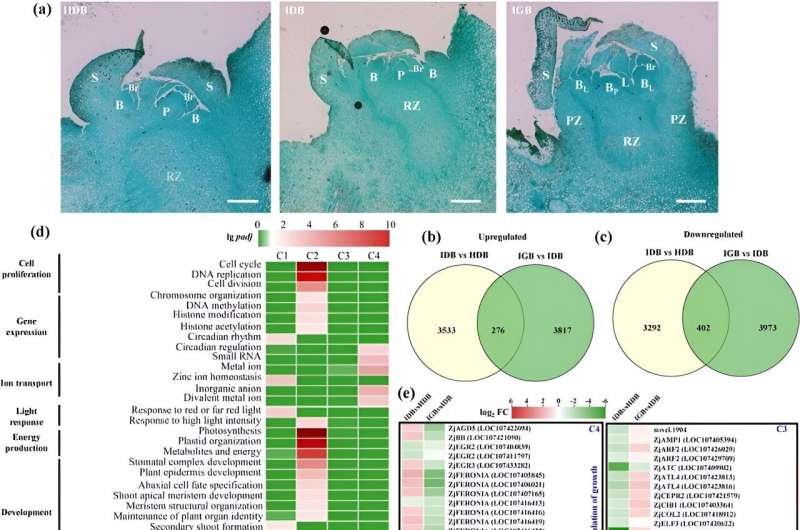This article has been reviewed according to Science X's editorial process and policies. Editors have highlighted the following attributes while ensuring the content's credibility:
fact-checked
peer-reviewed publication
proofread
Jujube witches' broom phytoplasmas inhibit ZjBRC1-mediated abscisic acid metabolism to induce shoot proliferation

Chinese jujube (Ziziphus jujuba Mill.), an important species in the Rhamnaceae family, has been cultivated in China for over 7,000 years and is vulnerable to Jujube witches' broom (JWB) disease. This disease, caused by the JWB plant pathogen, leads to overgrowth of axillary buds, affecting plant health and yield.
Previous studies identified two JWB effectors, SJP1 and SJP2, which disrupt ZjBRC1-mediated auxin flux, inducing lateral bud outgrowth. Despite these discoveries, the complete pathogenesis of JWB remains largely unknown. Understanding the interactions between jujube plants and JWB phytoplasmas, particularly the role of secreted proteins in affecting plant growth regulators, is crucial.
In July 2023, Horticulture Research published a research article titled "Haplotype analyses reveal novel insights into tomato history and domestication driven by long-distance migrations and latitudinal adaptations."
In this study, tissue-specific transcriptional reprogramming was employed to reveal the genetic mechanisms underlying the growth of jujube lateral buds infected with Jujube witches' broom (JWB) phytoplasma. Through tissue-specific RNA sequencing, 12,376 unique genes were identified as differential expressed in healthy and infected buds, with major changes observed in genes related to rapid growth and shoot system development.
Gene Ontology (GO) enrichment analysis further categorized these genes into clusters involved in diverse physiological processes, such as zinc ion homeostasis, response to light, circadian rhythm, and hormone pathways.
Among these findings, the study revealed a dynamic reprogramming of differential expressed genes towards bud outgrowth and lateral shoot formation. Key genes in the strigolactone pathway and those promoting axillary meristem development were notably up-regulated in infected buds.
Conversely, ABA synthesis genes were significantly down-regulated in infected compared to healthy dormant buds, leading to reduced ABA accumulation and correlating with rapid bud growth and expansion. Furthermore, the study highlighted the role of ZjBRC1, a gene involved in controlling lateral shoot branching.
It was observed that ZjBRC1 regulates genes related to ABA homeostasis and signaling, and its expression was negatively correlated with lateral main bud outgrowth in decapitated healthy jujube. The yeast two-hybrid assays indicated that ZjBRC1 forms heterodimers with other transcription factors, influencing its biological activity in suppressing lateral bud outgrowth.
In summary, the research methodically dissected the complex interactions between JWB phytoplasma and jujube plants. It elucidated how JWB phytoplasma manipulates hormone pathways, particularly the ABA pathway, through ZjBRC1 to stimulate lateral bud outgrowth.
This detailed investigation deepens the understanding of JWB disease pathogenesis and offers insights for developing JWB-resistant jujube varieties.
More information: Fuli Ma et al, Jujube witches' broom phytoplasmas inhibit ZjBRC1-mediated abscisic acid metabolism to induce shoot proliferation, Horticulture Research (2023). DOI: 10.1093/hr/uhad148
Journal information: Horticulture Research
Provided by Plant Phenomics




















